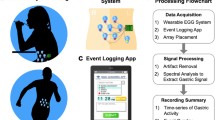Abstract
Background and Aims
Limited means exist to assess gastrointestinal activity in a noninvasive, objective way that is highly predictive of underlying motility disorders. The aim of this paper is to demonstrate the feasibility of recording myoelectric gastrointestinal activity by cutaneous patches and to correlate myoelectric signals with gastrointestinal function in various clinical settings.
Methods
A novel wireless patch system (WPS) (G-Tech Medical) that acquires gastrointestinal myoelectrical signals was placed on the patients’ anterior abdomens. Data were transmitted wirelessly to a mobile device with a user interface and forwarded to a cloud server where processing algorithms identified episodes of motor activity, quantified their parameters, and nominally assigned them to specific gastrointestinal organs based on their frequencies.
Results
The inherent reproducibility of the WPS measurement technique itself and from the underlying gut activity, coupled with source validation and sensitivity to changes in gut activity in several physiologic and pathologic states, demonstrates its feasibility, safety, and performance in clinical settings.
Conclusions
The novel WPS technology, measuring myoelectric intestinal activity noninvasively and continuously over multiple days, is feasible in a wide range of clinical settings, highlighting its promise in the diagnosis and management of motility disorders. Further research is required for more extensive validation and to determine how best to employ this information to optimize patient care.








Similar content being viewed by others
References
Talley NJ. Functional gastrointestinal disorders as a public health problem. Neurogastroenterol Motil. 2008;20:121–129. https://doi.org/10.1111/j.1365-2982.2008.01097.x.
Peery AF, Crockett SD, Barritt AS, et al. Burden of gastrointestinal, liver, and pancreatic diseases in the United States. Gastroenterology. 2015;149:1731–1741.e3. https://doi.org/10.1053/j.gastro.2015.08.045.
Kim ER, Rhee PL. How to interpret a functional or motility test—colon transit study. J Neurogastroenterol Motil. 2012;18:94–99. https://doi.org/10.5056/jnm.2012.18.1.94.
Kekilli E, Yagmur C, Isik B, Aydin OM. Calculating colon transit time with radionuclide-filled capsules in constipated patients: a new method for colon transit study. Abdom Imaging. 2005;30(5):593–597. https://doi.org/10.1007/s00261-005-0305-9. Epub May 2 2005. PMID: 15886950.
Hollenbach M, Hoffmeister A, Rosendahl J, Mössner J. Stellenwert der Funktionsdiagnostik in der Gastroenterologie [Importance of functional diagnostics in gastroenterology]. Internist (Berl). 2018;59:25–37. https://doi.org/10.1007/s00108-017-0359-0.
Saad RJ. The wireless motility capsule: a one-stop shop for the evaluation of GI motility disorders. Curr Gastroenterol Rep. 2016;18:14. https://doi.org/10.1007/s11894-016-0489-x.
Patcharatrakul T, Gonlachanvit S. Technique of functional and motility test: how to perform antroduodenal manometry. J Neurogastroenterol Motil. 2013;19:395–404. https://doi.org/10.5056/jnm.2013.19.3.395.
Dua MM, Navalgund A, Axelrod S, et al. Monitoring gastric myoelectric activity after pancreaticoduodenectomy for diet “readiness”. Am J Physiol Gastrointest Liver Physiol. 2018;315:G743–G751. https://doi.org/10.1152/ajpgi.00074.2018.
Navalgund A, Axelrod S, Axelrod L, et al. Colon myoelectric activity measured after open abdominal surgery with a noninvasive wireless patch system predicts time to first flatus. J Gastrointest Surg. 2019;23:982–989. https://doi.org/10.1007/s11605-018-4030-4.
Farmer AD, Wegeberg AL, Brock B, et al. Regional gastrointestinal contractility parameters using the wireless motility capsule: inter-observer reproducibility and influence of age, gender and study country. Aliment Pharmacol Ther. 2018;47:391–400. https://doi.org/10.1111/apt.14438.
Sarna SK, et al. Types of human colonic electrical activities recorded postoperatively. Gastroenterology. 1981;81:61–70.
Condon RE, Cowles VE, Ferraz AA, et al. Human colonic smooth muscle electrical activity during and after recovery from postoperative ileus. Am J Physiol Gastrointest Liver Physiol. 1995;269:G408–G417.
Su A, Gandhy R, Barlow C, Triadafilopoulos G. Utility of high-resolution anorectal manometry and wireless motility capsule in the evaluation of patients with Parkinson’s disease and chronic constipation. BMJ Open Gastroenterol. 2016;3:e000118. https://doi.org/10.1136/bmjgast-2016-000118.
Su A, Gandhy R, Barlow C, Triadafilopoulos G. Utility of the wireless motility capsule and lactulose breath testing in the evaluation of patients with Parkinson’s disease who present with functional gastrointestinal symptoms. BMJ Open Gastroenterol. 2017;4:e000132. https://doi.org/10.1136/bmjgast-2017-000132.
Vazquez Roque M, Bouras EP. Epidemiology and management of chronic constipation in elderly patients. Clin Interv Aging. 2015;10:919–930. https://doi.org/10.2147/cia.s54304.
Ford AC, Lacy BE, Talley NJ. Irritable bowel syndrome. N Engl J Med. 2017;376:2566–2578. https://doi.org/10.1056/NEJMra1607547.
Lacy BE, Patel NK. Rome criteria and a diagnostic approach to irritable bowel syndrome. J Clin Med. 2017;6:99. https://doi.org/10.3390/jcm6110099.
Ye Y, Garcia-Casado J, Martinez-de-Juan JL, Ponce JL. Empirical mode decomposition: a method to reduce low frequency interferences from surface electroenterogram. Med Biol Eng Comput. 2007;45:541–551. https://doi.org/10.1007/s11517-007-0189-7.
Ye-Lin Y, Garcia-Casado J, Prats-Boluda G, Ponce JL, Martinez-de-Juan JL. Enhancement of the non-invasive electroenterogram to identify intestinal pacemaker activity. Physiol Meas. 2009;30:885–902. https://doi.org/10.1088/0967-3334/30/9/002.
Wegman EA, Gandevia SC, Aniss AM. Concordance between colonic myoelectrical signals recorded with intramuscular electrodes in the human rectosigmoid in vivo. Gut. 1990;31:1289–1293. https://doi.org/10.1136/gut.31.11.1289.
Furness JB, Rivera LR, Cho HJ, Bravo DM, Callaghan B. The gut as a sensory organ. Nat Rev Gastroenterol Hepatol. 2013;10:729–740. https://doi.org/10.1038/nrgastro.2013.180.
Author information
Authors and Affiliations
Corresponding author
Ethics declarations
Conflict of interest
All authors have variable equity positions with G-Tech Medical.
Additional information
Publisher's Note
Springer Nature remains neutral with regard to jurisdictional claims in published maps and institutional affiliations.
Rights and permissions
About this article
Cite this article
Axelrod, L., Axelrod, S., Navalgund, A. et al. Pilot Validation of a New Wireless Patch System as an Ambulatory, Noninvasive Tool That Measures Gut Myoelectrical Signals: Physiologic and Disease Correlations. Dig Dis Sci 66, 3505–3515 (2021). https://doi.org/10.1007/s10620-020-06663-y
Received:
Accepted:
Published:
Issue Date:
DOI: https://doi.org/10.1007/s10620-020-06663-y




